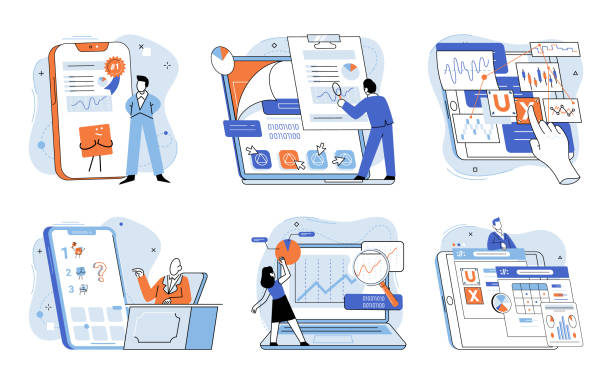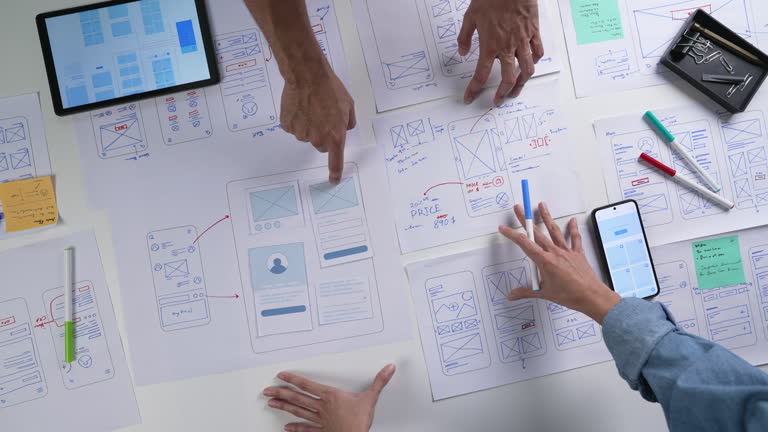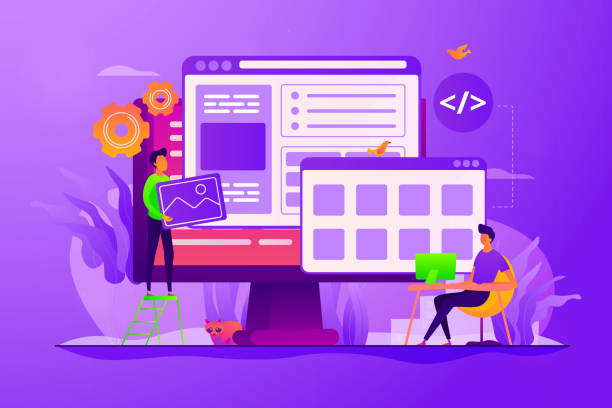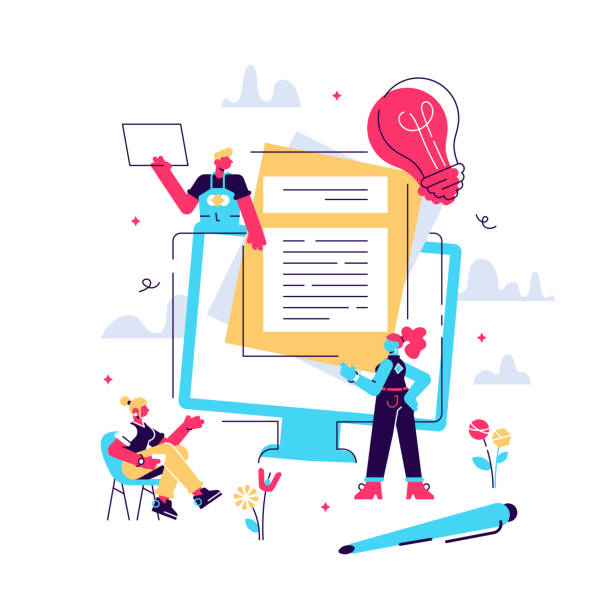Why is Fast Website Design Important?

#Website_Speed in today’s digital world is not an option, but a necessity.
When users have to wait long moments to access your website content, they are likely to leave you and turn to your competitors.
This is where the importance of fast website design becomes more evident.
User experience (UX) is directly related to page loading speed; the faster your site, the more satisfied users will be, and their likelihood of returning will increase.
Studies have shown that even a one-second delay in page loading can lead to a significant decrease in conversion rates.
Furthermore, site speed is a crucial factor in SEO ranking by search engines like Google.
Slower sites achieve lower positions in search results, which means losing organic and potential traffic.
In fact, Google constantly updates its algorithms to prioritize websites that offer the best user experience.
This experience includes high loading speed, proper responsiveness, and visual stability, all of which are subsets of Core Web Vitals.
Therefore, investing in speed optimization and fast website design is an investment in the future of your online business.
Not only from a technical and SEO perspective, but also from the user psychology perspective, speed conveys a sense of trust and professionalism.
Users trust sites that quickly meet their needs, and this trust can lead to customer loyalty and increased revenue.
Let’s delve deeper into this topic and discover the hidden reasons behind this necessity.
For more information on the importance of website speed, you can refer to reliable sources like Wikipedia.
Are you tired of losing business opportunities due to not having a professional corporate website?
Rasawb, with its professional corporate website design, helps you:
✅ Build a powerful and trustworthy image for your brand
✅ Convert website visitors into loyal customers
⚡ Get a free consultation now!
Key Factors in Increasing Website Loading Speed

#Code_Optimization and #Images are considered the cornerstones of increasing website loading speed.
To achieve a fast website design, special attention must be paid to a set of technical factors.
One of the most important factors is the size and quality of HTML, CSS, and JavaScript codes.
Extra, repetitive, or unorganized codes can severely slow down page loading.
Minification (removing extra characters like spaces and comments) and Concatenation (combining multiple CSS or JS files into one) can help reduce HTTP requests and consequently increase speed.
Also, make sure that JavaScript and CSS resources are optimized and render-blocking resources are properly managed.
Another important factor is #hosting and server responsiveness.
Even if your site’s code is fully optimized, a slow host can nullify all your efforts.
Choosing a reputable hosting provider with powerful servers and a suitable geographical location for your target audience is crucial.
Using #caching technologies such as browser cache, server cache, and object cache also significantly increases loading speed, as it doesn’t reload duplicate content.
Image size and format also play a key role.
High-volume images and unsuitable formats (like PNG for photos) can severely decrease site speed.
Using modern formats like WebP, proper image compression, and implementing Lazy Loading (loading images only when needed) are effective solutions in this area.
These factors together pave the way to achieving an ultra-fast website.
For more details on web performance optimization, you can refer to MDN Web Docs.
The Role of Hosting and Infrastructure in Site Speed

#Proper_Hosting is the backbone of any high-speed website and a crucial factor in fast website design.
The choice of hosting type and its infrastructure quality directly impacts server response time and ultimately the loading speed of your website pages.
Low-quality servers or overcrowded shared hosts can become a bottleneck for your site’s traffic and severely affect user experience.
The importance of sufficient #bandwidth and the proximity of the #data_center to your target audience should also not be overlooked; the shorter the distance data travels, the faster it reaches the user.
There are different types of hosting, each with its own advantages and disadvantages in terms of speed and cost.
Shared Hosting is the cheapest option, but its resources are divided among many websites, which can lead to reduced speed.
Virtual Private Server (VPS Hosting) offers more flexibility and dedicated resources and is suitable for websites with moderate traffic.
Dedicated Hosting and Cloud Hosting offer the best performance in terms of speed and stability, as resources are fully dedicated or dynamically scalable.
In the following, a table is provided comparing hosting types and their impact on website speed and performance:
| Hosting Type | Advantages (in terms of speed) | Disadvantages (in terms of speed) | Use Case |
|---|---|---|---|
| Shared Hosting | Quick setup, cost-effective | Limited resources, variable speed due to resource sharing | Small and personal websites |
| VPS Hosting | More dedicated resources, better server control | Requires more technical knowledge, more expensive than shared | Medium-sized websites, small online stores |
| Dedicated Hosting | Maximum speed and performance, full server control | Very expensive, requires server specialist | Large websites with high traffic |
| Cloud Hosting | High scalability, excellent stability and speed | More complexity, cost based on usage | Websites with variable traffic and web applications |
Choosing the right host for fast website design is the first step and one of the most important decisions in the optimization process.
You should always consider your website’s needs and choose the best option accordingly.
Reputable hosting companies often offer good advice in this area, which can help you make the right choice.
For choosing the right host, you can use specialized guides like Wikipedia on web hosting.
Website Speed Measurement Tools and Their Result Interpretation

#Speed_Measurement is the first crucial step in optimizing and achieving a fast website design.
Without accurate measurement, you cannot identify weaknesses and monitor your progress.
Fortunately, there are powerful and free tools that help you measure your website’s performance and receive comprehensive reports.
Three widely used and reliable tools in this area are: Google PageSpeed Insights, GTmetrix, and Lighthouse.
Google PageSpeed Insights is a Google tool that reports based on Lab Data and Field Data.
Field Data (CrUX) shows real user information and is generally more reliable.
This tool gives you a score from 0 to 100 for desktop and mobile and provides recommendations for improvement.
The important metrics Google focuses on are Core Web Vitals, which include LCP (Largest Contentful Paint), FID (First Input Delay – which will change to INP in the future), and CLS (Cumulative Layout Shift).
LCP indicates the loading time of the largest visual content on the page, FID refers to the initial interactivity of the page, and CLS measures visual stability.
GTmetrix is also a comprehensive tool that, in addition to displaying performance and structure scores, provides more detailed reports of waterfall charts, helping you see exactly which resources take the longest to load.
This tool also shows the Fully Loaded Time and the number of Requests.
Lighthouse is an open-source tool accessible as an extension in the Chrome browser or through Developer Tools.
This tool not only measures speed but also provides comprehensive reports on accessibility, best practices, and SEO.
By correctly interpreting the results of these tools, you can take effective steps to improve your fast website design and achieve performance goals.
To start measuring your site’s speed, you can directly visit the Google PageSpeed Insights page.
Are you tired of your e-commerce website not generating as much revenue as it could? Rasawb, specializing in professional e-commerce website design, solves this problem forever!
✅ Increase sales rate and revenue
✅ High loading speed and unparalleled user experience
⚡ Get a free e-commerce website design consultation
Optimizing Images and Media for More Speed

#Media_Optimization, especially images, is one of the most effective methods for achieving a fast website design.
Images and videos often constitute the largest portion of a web page’s size, and if not managed correctly, they can severely slow down site loading.
The first step in this regard is choosing the appropriate #image_format.
For photos, JPEG with good compression quality is suitable, and for low-detail and transparent graphics, PNG is appropriate.
However, more modern formats like WebP, developed by Google, can significantly reduce file size while maintaining similar quality.
WebP is suitable for both photos and graphics, and browser support for it is increasing daily.
After choosing the format, #image_compression without noticeable quality loss is important.
Many online and offline tools are available for this purpose that can reduce image size by up to 80%.
Also, ensure that images are saved with appropriate dimensions for display on your website; using images much larger than actually needed only leads to extra volume.
Implementing Responsive Images, which load the appropriate image version based on the user’s screen size, is another key technique.
One of the most powerful techniques for increasing initial page load speed is #Lazy_Loading images and videos.
With this method, media are only loaded when the user scrolls to the relevant part of the page.
This makes the initial page load much faster and essential content available to the user more quickly.
For videos, instead of direct loading, you can use lazy loading or links to video streaming services like YouTube or Vimeo and only display the cover image (Thumbnail).
By following these tips, you can significantly reduce the overall size of your pages and achieve a fast and efficient website design.
For more guidance, you can refer to reputable articles on image optimization, such as those published in Smashing Magazine.
The Importance of Clean Coding and Using Lightweight Frameworks

#Optimized_Code is the beating heart of every fast and efficient website design.
The size and quality of HTML, CSS, and #JavaScript codes directly impact the loading speed and overall performance of a website.
Disorganized, repetitive, or unnecessary codes can lead to “Bloated Code,” which not only increases file size but also slows down their processing by the browser.
Therefore, adhering to the principles of clean and optimized coding is of high importance.
This includes removing Dead Code, using optimized CSS stylesheets (like Flexbox and Grid instead of old floats), and minimizing the use of heavy and unnecessary JavaScripts.
One effective solution for reducing code size is Minification; a process in which all unnecessary characters like spaces, tabs, and comments are removed from code files without altering their functionality.
Also, Concatenation, or combining several small CSS or JS files into a larger one, can help reduce the number of HTTP requests and consequently improve loading speed.
Choosing a #lightweight_framework is also very important in this regard.
Some web development frameworks, due to their extensive features and comprehensiveness, add a large amount of code to the project, even if not all their functionalities are used.
Choosing lighter frameworks or even using Vanilla JS (pure JavaScript) and simple CSS for smaller projects can make a significant difference in speed.
For larger projects, using Bundle Splitting tools to divide the code into smaller parts that are only loaded when needed is recommended.
Additionally, on the backend, optimizing the #database and its queries is also crucial.
Inefficient queries can significantly increase server response time.
Ensuring that your database has proper indexes and that queries are optimally written greatly helps improve overall performance and achieve fast website design.
Adhering to these technical principles forms the foundation of a high-performing website.
For more information on coding standards and best practices, you can refer to resources like W3C standards.
CDN and Caching: The Hidden Secrets of High Speed

#CDN (Content Delivery Network) and #Caching are two key concepts in website speed optimization, often known as the “hidden secrets of high speed” in fast website design.
A CDN is a network of distributed servers in various parts of the world that caches your website’s static content (such as images, CSS, JavaScript) and delivers it from the server closest to the end-user.
This significantly reduces loading time, as data does not need to travel a long distance from your origin server.
Using a CDN is almost essential for websites with a global audience or high traffic and plays a vital role in accelerating site loading.
Caching is also a process in which copies of website content are stored to be quickly retrieved from cache on subsequent visits or by other users.
There are different types of caching, each operating at a specific layer of web architecture:
| Caching Method | Description | Speed Benefit | Implementation |
|---|---|---|---|
| Browser Cache | Stores files in the user’s browser for subsequent visits | Reduces HTTP requests, faster loading for returning users | Configure Cache-Control headers on the server |
| Server Cache | Stores prepared versions of pages or data on the server | Reduces server load, faster server response | Use plugins (CMS) or server settings (Nginx, Apache) |
| Object Cache | Stores database query results and complex computations | Reduces backend processing time, accelerates content generation | Tools like Redis or Memcached |
Combining CDN with comprehensive #caching strategies can significantly improve your website’s loading speed and set it on the path to fast website design.
These techniques become even more important for dynamic websites whose content constantly changes, as they can minimize the load on the main server.
Ultimately, the correct implementation of these tools allows your website to be accessible to all users worldwide with high efficiency and an unparalleled user experience.
To understand CDNs more deeply, you can use the explanations from Cloudflare.
User Experience and Fast Website Design: An Unbreakable Connection

#UX (User Experience) and #UI (User Interface) are concepts deeply intertwined with website speed.
In fact, fast website design is not just a technical aspect, but a fundamental pillar in providing an unparalleled user experience.
Have you ever considered what impact even a few hundredths of a second delay in page loading has on a user’s mood and decision-making? Research shows that users are highly sensitive to website response speed, and a slow site can lead to frustration, loss of focus, and ultimately site abandonment.
High speed conveys a sense of professionalism and trustworthiness to the user.
When a site loads quickly and responds to user commands, the user feels they are dealing with an efficient and up-to-date system.
This positive feeling leads to #customer_loyalty and #user_trust.
Conversely, slow sites, even if they have very valuable content, can create the impression that the website is neglected or unreliable.
In fact, speed is an invisible element of user interface design that directly affects user perception and interaction.
Furthermore, speed affects users’ ability to complete their tasks on your website.
Whether they are shopping online, looking for information, or filling out a form, any delay can disrupt the process and reduce the conversion rate.
Faster sites enable users to browse your site easily and without interruption, leading to increased dwell time and reduced bounce rate.
Therefore, fast website design not only means technical optimization but also investing in user satisfaction and your business’s long-term success.
Can we really ignore speed in today’s world and expect users to remain patient? For more study on the importance of user experience, you can refer to articles published by the Nielsen Norman Group.
Are you missing business opportunities because of an outdated website? With Rasawb, forever solve the problem of not attracting potential customers through your website!
✅ Attract more high-quality leads
✅ Enhance brand credibility in customers’ eyes
⚡ Get a free corporate website design consultation
Challenges and Modern Solutions in Fast Website Design

In the dynamic world of the web, #continuous_optimization to maintain a position in the #competition and achieve a fast website design is an ongoing challenge.
With the emergence of new technologies and growing user expectations, web developers must always stay up-to-date.
One of the most important recent developments that has presented new challenges is Google’s focus on Core Web Vitals.
These new metrics (LCP, FID/INP, CLS) not only focus on technical speed but also emphasize the user’s visual and interactive experience.
This means that merely having a fast page load is not enough; you must ensure that the page loads stably, without sudden element shifts, and with high interactivity.
Another challenge is the increasing complexity of websites and single-page applications (SPAs), which often load a large volume of JavaScript.
This can lead to processing and interactivity delays.
Modern solutions to address these challenges include using new coding trends like Hydration and Server-Side Rendering (SSR) for JavaScript frameworks, as well as using ES Modules for optimized code loading.
In the networking sector, #new_technologies like HTTP/3, built on the QUIC protocol, promise faster and more reliable communications.
Additionally, using more advanced compression algorithms like Brotli (instead of Gzip) can more effectively reduce file sizes.
Implementing Service Workers to enable offline capabilities and improve reload speed, and using Prefetching and Preloading for proactive resource loading, are among other modern solutions in fast website design.
Awareness of these developments and their continuous implementation is key to maintaining competitiveness and providing a flawless user experience.
For the latest news and updates on Core Web Vitals and site optimization, you can refer to the Google Search Central blog.
The Future of Web Design and Speed: Upcoming Trends

As technology advances at an incredible pace, the future of #semantic_web and #web_design is also moving towards faster and more immersive experiences.
Fast website design, which is currently a competitive advantage, will soon become an indispensable standard.
It is predicted that trends such as Web 3.0 and the Metaverse will increasingly highlight the need for unprecedented speeds in loading and interaction.
The role of #Artificial_Intelligence and #Machine_Learning in speed optimization will also increase.
AI algorithms can automatically compress images, remove unnecessary codes, and even predict the optimal content delivery path based on user behavior.
These automatic optimizations minimize the time and effort required to achieve maximum speed.
Furthermore, with the expansion of 5G internet and more stable connectivity, user expectations for speed will be instantaneous, and any delay, even in milliseconds, will be easily noticeable.
The development of newer communication protocols, such as the evolution of HTTP and advancements in data compression, will lead to more efficient information transmission and reception.
Web development frameworks are also moving towards “Islands Architecture”; an approach where only interactive parts of the page are loaded with JavaScript, and the rest of the page remains static and very lightweight.
These architectural changes will radically increase loading speed and interactivity.
Ultimately, the #future_of_web is moving towards a completely frictionless and instantaneous experience, where speed, as a fundamental rather than an additional feature, is ingrained in the heart of fast website design.
For developers and website owners, this means the necessity of continuous learning, experimentation, and adaptation to these new trends to ensure a successful and engaging digital presence in the future.
Staying at the cutting edge of science and technology is key to reaching this bright future.
To explore future web predictions, you can refer to reputable articles in this field, such as those on web.dev.
Frequently Asked Questions
| Row | Question | Answer |
|---|---|---|
| 1 | What is meant by fast website design? | Fast website design refers to the process of launching a functional and optimized website in the shortest possible time, without sacrificing its quality or efficiency. |
| 2 | What factors are effective in website design speed? | Using ready-made Content Management Systems (CMS) like WordPress, optimized ready-made templates, visual design tools, designer experience, and effective communication with the client. |
| 3 | Does fast website design always mean reduced quality? | No, with proper planning, using optimized tools, and standard techniques, a high-quality website can be designed in a short time. |
| 4 | What types of websites are most suitable for fast design? | Small corporate websites, blogs, online resumes, landing pages, and e-commerce stores with limited products. |
| 5 | What is the role of CMSs (like WordPress) in fast design? | CMSs significantly accelerate the design and development process by providing templates, plugins, and an easy-to-use admin panel. |
| 6 | Does fast website design cost less? | Usually, yes. Due to reduced designer working hours and the use of ready-made resources, costs can be significantly reduced. |
| 7 | What information is needed from the client for fast design? | Contact information, logo, textual content, images, website goals, and any specific customization needs. |
| 8 | Do fast-designed websites have future scalability? | Yes, especially if built with popular CMSs like WordPress, new features can be easily added to them in the future. |
| 9 | What benefits does fast website design offer businesses? | Faster market entry, testing new ideas with minimal risk, reduced costs, and the ability to launch immediate marketing campaigns. |
| 10 | What is the difference between fast website design and a “ready-made website”? | Fast design involves the process of designing and implementing based on client needs, even if it uses ready-made tools. However, “ready-made website” usually refers to platforms where you only input your information and receive a pre-defined website. |
And other services of Rasa Web Advertising Agency in the field of advertising
Smart Reportage: A combination of creativity and technology for user interaction through custom programming.
Smart Marketplace: A professional solution to increase website traffic with a focus on precise audience targeting.
Smart Marketing Automation: Professional optimization to increase sales using custom programming.
Smart Reportage: Professional optimization to increase click-through rate using real data.
Smart Link Building: A specialized service for increasing click-through rates based on user experience customization.
And over a hundred other services in the field of internet advertising, advertising consulting, and organizational solutions
Internet Advertising | Advertising Strategy | Advertorial
Resources
10 Tips to Increase Your Site Speed
Complete Guide to Website Speed Optimization
The Importance of User Experience in Web Design
How to Improve Your Site’s SEO
? Are you looking for a digital transformation for your business? Rasawb Afarin Digital Marketing Agency paves your growth path by offering services such as professional website design, SEO, and social media management. Trust us to make your online presence shine and bring your business to the pinnacle of success.
📍 Tehran, Mirdamad Street, Next to Central Bank, Southern Kazeroun Alley, Ramin Alley, No. 6




